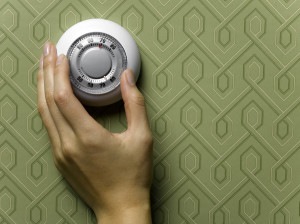
In answer to one of my many “why?” questions about how poorly we understand energy, engineer Marc Rosenbaum explained, “Honeywell put us to sleep!”
What did he mean?
Not that long ago when it was cold out, it was kinda cold in. Or hot for that matter. We had a pretty visceral relationship with our climate. Getting warm or staying cool were relative conditions that we tolerated broadly. There were fuels to gather and places to burn them, layers of clothing to assemble or shed, buildings shaped to shelter us from what was harsh or gather what was desirable: a breeze when it was hot or the sun when it was cold.
Along comes the industrial revolution and the discovery of oil, gas, and the generation and distribution of electricity and systems that could convert these remarkable sources of what was soon abundant energy into plentiful heat, and later cooling. It wasn’t long before there was this gizmo on the wall that would allow us to choose a steady state of comfort. That ubiquitous round thermostat was manufactured by Honeywell.
Why does it matter?
Well, once we had this comfort switch on the wall, and it was connected to a system that would churn out that comfort without requiring us to ever think much about it, we could go ahead and design buildings that were pretty much indifferent to the need to accommodate their climate. “Honeywell” took care of that.
We could, and did, add lots of windows, and created architectural bumps and jogs, and made our rooms taller, and our houses larger, all without consequence to our comfort. Honeywell took care of that. Well, almost.
Despite the mechanical marvels that promise us reliable comfort, many of our homes aren’t actually that comfortable. They can be drafty, hot here and cold there, stuffy, dry, dusty, moldy – all the while that thermostat is assuring us of a constant setting.
It has been our design habit to design the building the way we want it and, without climatic consequence, to expect those systems to make it comfortable. Honeywell put us to sleep.
If we wake up and pay attention, it turns out that we can actually have remarkably greater comfort, use less energy, and become aligned with the climate we live within. When we talk about Future Friendly Homes and Passive Houses we are talking about buildings that rely first on the genius of the building itself, and last on the small fraction of energy and systems we actually need to live much more comfortably than we presently know. Homes built with this wide-awake awareness are cleaner, healthier, have constant fresh air, and are reliably comfortable in every corner of the house.
It’s time to wake up!

